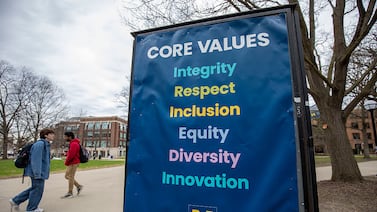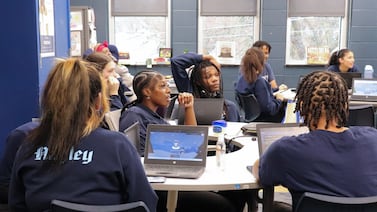Sign up for Chalkbeat Newark’s free newsletter to keep up with the city’s public school system.
New Jersey school districts are using virtual learning to fill educational gaps caused by teacher shortages, but advocates and lawmakers say they don’t have a clear picture of how many classes are taught virtually.
At a joint meeting of the Senate and Assembly education committees, teachers, superintendents, advocates, and virtual learning companies shared anecdotal evidence about how online instruction is used in schools. Advocates urged lawmakers to pass legislation directing the Department of Education to collect data on online instruction and impose regulations.
The state is continuing to face a shortage of teachers and other staff, which is leading schools to turn to virtual instruction in what several superintendents said is a last resort. Speakers agreed that an in-person teacher is preferable to a virtual one whenever possible, but often there are no qualified teachers available.
“There is a teacher shortage, and it is at a crisis stage. As a result of that, we need alternatives to be able to properly educate our children,” Hamilton Township Superintendent Scott Rocco said. “As superintendents in the state of New Jersey, we want highly qualified New Jersey certified teachers in front of our students. They are not available.”
Rocco said his district has supplemented its in-person education with online services after exhausting every option, from hiring a new teacher to finding current teachers to take on an additional class during their prep or duty period, when they would not normally be teaching.
Districts still looking for in-person teachers
Even after signing a contract with an online vendor, Rocco said the district continues to look for in-person teachers for every classroom. In the meantime, online learning has worked as a last resort, he said.
Superintendents using virtual learning in their districts said they view it as a temporary solution while they look for full-time teachers. But the New Jersey Education Association, the largest teachers union in the state, expressed concern that without regulations the practice could become more widespread.
“Virtual instruction cannot be normalized in New Jersey public schools. It is our collective responsibility to ask for clear direction to rein in what is happening under the radar right now,” said Deb Cornavaca, NJEA government relations director.
Because school districts’ contracts with providers of virtual instruction are approved by local school boards, there is no statewide data about the use of online learning.
In some cases, the virtual teacher meets with students in real time and in others, students access online material at their own pace without live sessions. School districts are using online learning as short-term and full-year solutions at every school level, Cornavaca said.
Is current virtual instruction legal?
Cornavaca warned the way virtual instruction is being used right now may be illegal, because there is no legal basis for virtual instruction in the state except for individualized student learning opportunities and health emergencies, she said. Representatives of other education groups disagreed.
Jennifer Paulino, a high school technology teacher, said in her district, Robbinsville, the district dismissed about 25 teachers and replaced two of them with online instructors. In one class, physics, the course is now taught without any hands-on learning and looks more like a study hall, with kids socializing and doing work for other classes, she said. The courses are offered asynchronously, so students must ask any questions over email and wait for a response, Paulino said.
George Solter, superintendent of North Bergen School District, said his district is using the online service Proximity Learning for three classes in the district. Once the district finds teachers, it will terminate its contract with Proximity, which runs on a month-to-month basis, he said.
Proximity’s founder Evan Erdberg said the company’s goal is not to replace in-person learning but to give students access to a certified teacher while their district looks for an in-person teacher. The company has over 40 clients in the state, he said. The company’s teachers use the local school district’s curriculum and only offer synchronous sessions.
Many of Proximity’s teachers are recent retirees or people on maternity leave from teaching positions in New Jersey because the company allows teachers to work part time, Erdberg said. A growing proportion of teachers are millennials, who want more flexibility to teach from anywhere and travel, he added.
Another online provider, Imagine Learning, is in around two dozen New Jersey districts, according to Dan Savarese, the company’s partnership manager for New Jersey.
“We’re not there to replace a teacher. We’re there as a backup plan to schools,” said Kimberlin Rivers, Imagine Learning’s vice president of instruction.
Hannah Gross covers education and child welfare for NJ Spotlight News via a partnership with Report for America. She covers the full spectrum of education and children’s services in New Jersey and looks especially through the lens of equity and opportunity. This story was first published on NJ Spotlight News, a content partner of Chalkbeat Newark.






